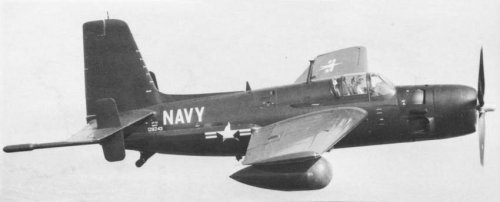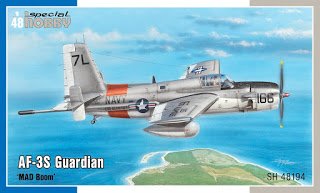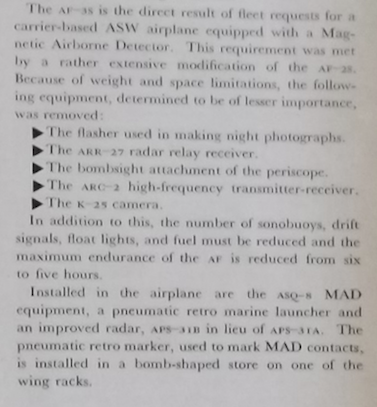- Joined
- 21 May 2006
- Messages
- 2,703
- Reaction score
- 1,604
G'day all
I have a technical question if I may in relation to the Grumman AF-3F Guardian and the fitting of its externally-mounted retractable ASQ-8 Magnetic Anomaly Detector (MAD) boom "scabbed" onto the starboard (right) side of it's fuselage, to make it a more effective submarine killer.
In an article I've read by Tommy H. Thomason (http://tailspintopics.blogspot.com/2015/02/grumman-af-guardian-notes.html?m=1)
Tommy H. Thomason states that due to the added weight and space required (and I dare say drag) of fitting the MAD system and the large APS-31B surface-search radar under the right wing "required removal of some equipment and stores capability, " as well as a reduction of onboard fuel, which intern reduced the AF-3S's endurance from six to five hours.
My question of curiosity is just how big and heavy was this ASQ-8 MAD system?
For although the MAD boom seems obvious, how much and how big was the actual technical/systems/componentry of this ASQ-8 within the aircraft itself?
Did the 'unseen' internal technical/systems - 'black boxes' of MAD get smaller/more compact and lighter by the 1960's?
The reason I'm asking this is related to my curiosity as to whether such externally-mounted/scabbed retractable Magnetic Anomaly Detector (MAD) would be viable as a capability upgrade to other/existing ASW aircraft like the Breguet Be.1050 Alize for example.
Regards
Pioneer
I have a technical question if I may in relation to the Grumman AF-3F Guardian and the fitting of its externally-mounted retractable ASQ-8 Magnetic Anomaly Detector (MAD) boom "scabbed" onto the starboard (right) side of it's fuselage, to make it a more effective submarine killer.
In an article I've read by Tommy H. Thomason (http://tailspintopics.blogspot.com/2015/02/grumman-af-guardian-notes.html?m=1)
Tommy H. Thomason states that due to the added weight and space required (and I dare say drag) of fitting the MAD system and the large APS-31B surface-search radar under the right wing "required removal of some equipment and stores capability, " as well as a reduction of onboard fuel, which intern reduced the AF-3S's endurance from six to five hours.
My question of curiosity is just how big and heavy was this ASQ-8 MAD system?
For although the MAD boom seems obvious, how much and how big was the actual technical/systems/componentry of this ASQ-8 within the aircraft itself?
Did the 'unseen' internal technical/systems - 'black boxes' of MAD get smaller/more compact and lighter by the 1960's?
The reason I'm asking this is related to my curiosity as to whether such externally-mounted/scabbed retractable Magnetic Anomaly Detector (MAD) would be viable as a capability upgrade to other/existing ASW aircraft like the Breguet Be.1050 Alize for example.
Regards
Pioneer
Attachments
Last edited:



